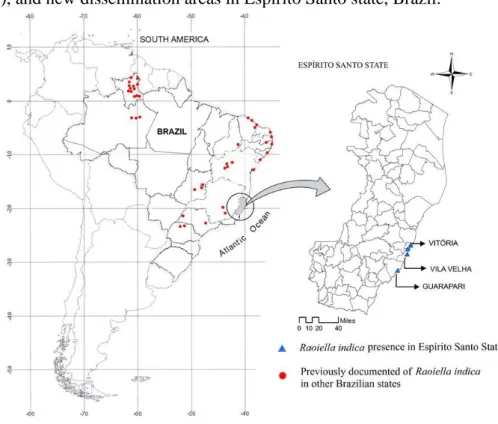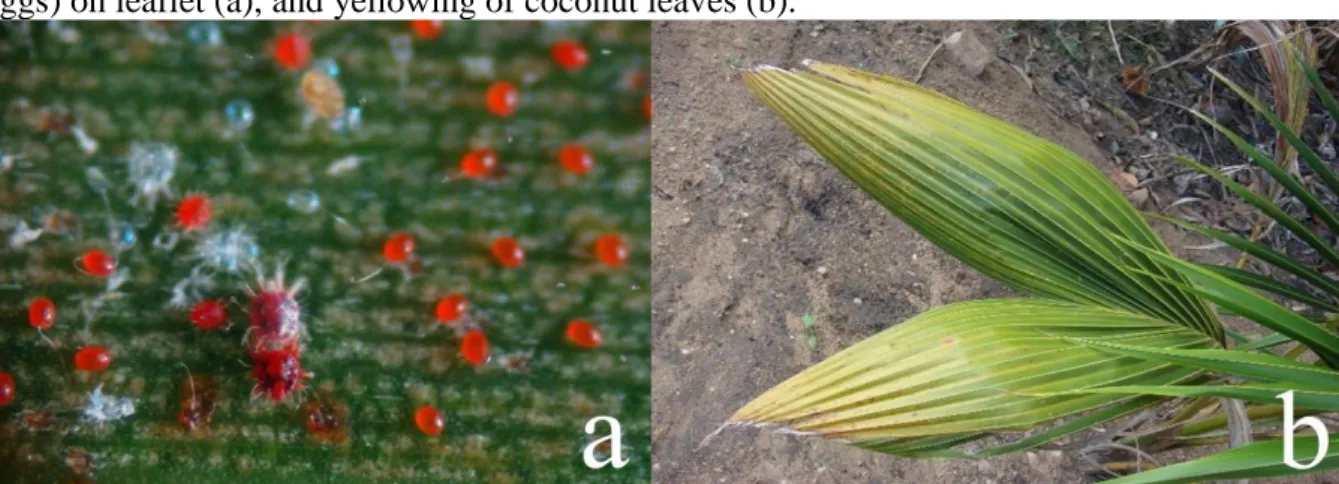CIENTIFIC NOTES
FIRST REPORT OF THE RED PALM MITE, Raoiella indica Hirst (Acari: Tenuipalpidae) IN ESPÍRITO SANTO STATE, BRAZIL
Alberto Luiz Marsaro Júnior1, Denise Navia2, Maurício José Fornazier3*, David dos Santos Martins3, José
Salazar Zanuncio Junior3, João Marcos Augusto Chipolesch3
1Entomologist, Embrapa Trigo, Cx. Postal 3081, Passo Fundo, RS, CEP 99001-970, Brazil, alberto.marsaro@embrapa.br; 2Acarologist, Embrapa Recursos Genéticos e Biotecnologia, Cx. Postal 02372, CEP 70770-900, Brasília, DF, Brazil, denise.navia@embrapa.br; 3Entomologist, Incaper, Cx. Postal 47, Venda Nova do Imigrante, ES, CEP 29375-000, Brazil, mauriciofornazier@gmail.com; davidmartins@incaper.es.gov.br; jose.zanuncio@incaper.es.gov.br; joaomarcosac@gmail.com.
*Corresponding author: mauriciofornazier@gmail.com
ABSTRACT: Raoiella indica Hirst (Acari: Tenuipalpidae) is an important pest of coconut trees
(Cocos nucifera L., Arecaceae). This mite is recorded for the first time in Espírito Santo state. This pest species was collected in coconut trees, and pygmy date palm (Phoenix roebelenii O'Brien, Arecaceae) in the municipalities of Guarapari, Vila Velha and Vitória in January 2018. A brief history of its worldwide distribution and occurrence in Brazil, a synthesis of its host plants, damages, and suggestions of actions to avoid its dissemination in this Brazilian state are discussed.
KEYWORDS: Geographic distribution. Host plants. Invasive mite. Quarantine pest. Red
palm mite.
RESUMO: Raoiella indica Hirst (Acari: Tenuipalpidae) é importante praga para a cultura do
coqueiro (Cocos nucifera L., Arecaceae). Esse ácaro é registrado pela primeira vez no estado do Espírito Santo. Essa espécie foi coletada em plantas de coqueiro e de tamareira-anã (Phoenix
roebelenii O'Brien, Arecaceae) nos municípios de Guarapari, Vila Velha e Vitória em janeiro
de 2018. Breve histórico da distribuição desta espécie praga no mundo e ocorrência no Brasil, síntese de suas plantas hospedeiras e seus danos, e sugestões de ações para evitar sua disseminação nesse estado brasileiro são discutidos.
PALAVRAS-CHAVE: Ácaro invasor. Ácaro vermelho das palmeiras. Distribuição
geográfica. Plantas hospedeiras. Praga quarentenária.
The red palm mite (RPM), Raoiella indica Hirst (Acari: Tenuipalpidae) was first reported in 1924 infesting coconut trees (Cocos nucifera L., Arecaceae) in India (HIRST, 1924). Subsequently, it was recorded in Africa (MOUTIA, 1958), and in the Middle East (GERSON et al., 1983). A few years later RPM was found in the French island of Martinique (FLECHTMANN; ETIENNE, 2004), in several other Caribbean islands (KANE et al., 2005; ETIENNE; FLECHTMANN, 2006; RODRIGUES et al., 2007), and it is related in fifteen countries of Central America and Caribbean (CABI, 2018). In 2007, this mite species was found in Florida, USA (WELBOURN, 2009), and in Venezuela (VÁSQUEZ et al., 2008). It was reported in Mexico (NAPPO, 2009), and later in Colombia (CARRILLO et al., 2011). In Brazil, RPM was detected for first time in 2009 infesting coconut and banana plants (Musa spp., Musaceae) in the state of Roraima (NAVIA et al., 2011). Soon after, RPM was found in the state of Amazonas (RODRIGUES; ANTONY, 2011), and its occurrence was restricted to the Northern Brazil. In less than ten years, this pest species has spread to thirteen other Brazilian states in the Northeastern (Alagoas, Bahia, Ceará, Paraíba, Pernambuco, Piauí, Rio Grande do Norte, and Sergipe), Midwest (Distrito Federal, and Goiás), Southeast (Minas Gerais, and São
Paulo), and Southern Brazil (Paraná) (OLIVEIRA et al., 2016; HATA et al., 2017; CABI, 2018; MELO et al., 2018) (Figure 1).
Reddish mites were observed in coconut leaflets in January 2018 in the municipalities of Guarapari (20°39'09.7"S, 40°28'36.5"W), and Vitória (20°17'57.3"S, 40°17'27.7"W, and 20°19'05.5"S; 40°19'11.0"W), and in pygmy date palm (Phoenix roebelenii O'Brien, Arecaceae) in Vila Velha (20°21'09.5"S; 40°17'13.6"W) in Espírito Santo state, Brazil, at sea level (Figure 1). Samples of leaflets (2x1 cm) of these plant species, with mites (adults, immature stages, and eggs) were conditioned in Eppendorf tubes with 70% alcohol, and sent to the Laboratory of Quarantine Plants of Embrapa Genetic Resources and Biotechnology, Brasília-DF, Brazil. For identification, the mites (females, males, and immature stage) were clarified in Nesbitt fluid for 48 hours at room temperature (~25ºC), and then mounted on microscope slides in Hoyer's medium. The identification of the mite species was carried out using objective microscope of phase contrast with objectives of 40 and 100x, referring to the original description of the species, and also comparing with specimens collected in Martinique, where this mite was found for first time in the Americas. Specimens were identified as R. indica (Figure 2a). After confirming its identification, the Federal Superintendence of Agriculture, Livestock and Supply of Espírito Santo was informed about the occurrence of this pest in the municipalities of the state.
Symptom of RPM infestation in host plants is the yellowing of leaves (Figure 2b), evolving to their complete dryness. RPM may cause the death of young plants when mite population is high (SATHIAMMA, 1996). In Trinidad, coconut production declined 70% after the infestation of this mite species (unpublished information from Philippe Agostini, President of Trinidad and Tobago Coconut Growers Association, reported by RODA et al., 2012). The list of host plants of RPM includes 91 species of the families Arecaceae, Heliconiaceae, Musaceae, Pandanaceae, Strelitziaceae and Zingiberaceae (CARRILLO et al., 2012). In Brazil, RPM has infested native and exotic plants, with the Arecaceae family having the highest number of related host plants (NAVIA et al., 2015).
Figure 1: Brazilian states with report of Raoiella indica Hirst (Acari: Tenuipalpidae) (MELO et al., 2018), and new dissemination areas in Espírito Santo state, Brazil.
Its rapid dissemination in Brazil, and this report in Espírito Santo state show the great invasiveness capacity of this mite. May be that the introduction of this pest in this state has occurred naturally, through the wind from neighboring states such as Minas Gerais and Bahia where RPM had been reported (MELO et al., 2018). However, the movement of ornamental host plants including coconuts (leaves, flowers, fruits, seedlings, and adult plants), and other palm plants for landscaping purposes from other Brazilian infested regions may be the most feasible possibility. In addition, considering that the municipalities where RPM was found in Espírito Santo are very demanded by tourists from all over Brazil, there is a high possibility that RPM had also been introduced through the clothes, vehicles, etc. of these tourists. However, the municipalities where this mite was detected are relatively far from the Northern Espírito Santo, the main green coconut producer-region in this Brazilian state. Phytosanitary measures need to be improved in the localities where RPM has already been found, such as phytosanitary alerts, inspection of coconut plants and other possible hosts, and integrated management of this mite due to avoid its spread to coconuts producing-region.
Figure 2. Raoiella indica Hirst (Acari: Tenuipalpidae): colony (adults, immature stage, and eggs) on leaflet (a), and yellowing of coconut leaves (b).
Photos: Marsaro Júnior, A. L.
On the other hand, Espírito Santo is an important producer of bananas and ginger (Zingiber officinale Roscoe, Zingiberaceae). Infestation of RPM in ginger may be possible, since this mite has already been reported in Zingiber sp. (Peña et al., 2006). It is not possible to forecast the direct impact of RPM attack on these crops in this Brazilian state. However, it may influence ginger exports to countries in the European Community where RPM is not reported yet, and also to the USA where this mite species is considered under eradication (CABI, 2018). Thus, it is necessary to monitor RPM dissemination to all municipalities of Espírito Santo aiming to verify its occurrence and host plants, mainly in areas cultivated with coconut trees, bananas, and ginger. Thus, measures must be taken to avoid its dissemination, and to implement its integrated management in places where this species could be present, as well as to avoid future impacts on the exports of this Brazilian state.
REFERENCES
CABI. Raoiella indica (red palm mite) datasheet. 2018. Invasive species compendium. Available at: <https://www.cabi.org/isc/datasheet/46792>. Access: 21 jun. 2018.
CARRILLO, D. et al. First report of Raoiella indica (Acari: Tenuipalpidae) in Colombia.
CARRILLO, D. et al. Host plant range of Raoiella indica (Acari: Tenuipalpidae) in areas of invasion of the New World. Experimental and Applied Acarology, v.57, p.271–289, 2012. ETIENNE, J.; FLECHTMANN, C. H. W. First record of Raoiella indica (Hirst, 1924) (Acari: Tenuipalpidae) in Guadeloupe and Saint Martin, West Indies. International Journal of
Acarology, v.32, p.331-332, 2006.
FLECHTMANN, C. H. W.; ETIENNE, J. The red palm mite, Raoiella indica Hirst, a threat to palms in the Americas (Acari: Prostigmata: Tenuipalpidae). Systematic and Applied
Acarology, v.9, p.109-110, 2004.
GERSON, U.; VENEZIAN, A.; BLUMBERG, D. Phytophagous mites on date palms in Israel. Fruits, v.38, p.133-135, 1983.
HATA, F. T. et al. First report of Raoiella indica (Hirst) (Acari: Tenuipalpidae) in southern Brazil. Neotropical Entomology, v.46, p.356–359, 2017.
HIRST, S. On some new species of red spiders. Annals and Magazine of Natural History, v.14, p.522-527, 1924.
KANE, E. et al. Raoiella indica (Acari: Tenuipalpidae), an island hopping mite pest in the
Caribbean. 2005. United States Department of Agriculture Research, Education, and
Economics Agricultural Research Service. 8p.
MELO, J. W. S. et al. The invasive red palm mite, Raoiella indica Hirst (Acari:
Tenuipalpidae), in Brazil: range extension and arrival into the most threatened area, the Northeast Region. International Journal of Acarology, 2018. Available at:
<https://doi.org/10.1080/01647954.2018.1474945>. Access: 11 jun. 2018.
MOUTIA, L. A. Contribution to the study of some phytophagous acarina and their predators in Mauritius. Bulletin of Entomological Research, v.49, p.59-75, 1958.
NAPPO. Detection of the red palm mite (Raoiella indica) in Cancun and Isla Mujeres,
Quintana Roo, Mexico. 2009. Available at:
<http://www.pestalert.org/oprDetail.cfm?oprID=406>. Access: 22 jun. 2018. NAVIA, D. et al. First report of the red palm mite, Raoiella indica Hirst (Acari: Tenuipalpidae), in Brazil. Neotropical Entomology, v.40, p.409–411, 2011.
NAVIA, D. et al. Ácaro-vermelho-das-palmeiras, Raoiella indica Hirst. In: VILELA, E. F.; ZUCCHI, R. A. (Ed.). Pragas introduzidas no Brasil: insetos e ácaros. Piracicaba: FEALQ, 2015. p. 418-452.
OLIVEIRA, D. C. et al. First report of Raoiella indica (Acari: Tenuipalpidae) in southeastern Brazil. Florida Entomologist, v.99, n.1, p.123-125, 2016.
RODA, A. et al. Spatial distributions of the red palm mite, Raoiella indica (Acari: Tenuipalpidae) on coconut and their implications for development of efficient sampling plants. Experimental and Applied Acarology, v.57, p.291–308, 2012.
RODRIGUES, J. C. V.; ANTONY, L. M. K. First report of Raoiella indica (Acari:
Tenuipalpidae) in Amazonas State, Brazil. Florida Entomologist, v.94, p.1073–1074, 2011. RODRIGUES, J. C. V.; OCHOA, R.; KANE, E. First report of Raoiella indica Hirst (Acari: Tenuipalpidae) and its damage to coconut palms in Puerto Rico and Culebra Islands.
International Journal of Acarology, v.33, p.3-5, 2007.
SATHIAMMA, B. Observations on the mite fauna associated with the coconut palm in Kerala, India. Journal of Plantation Crops, v. 24, p.92-96, 1996.
VÁSQUEZ, C. et al. First report of Raoiella indica Hirst (Acari: Tenuipalpidae) in South America. Neotropical Entomology, v.37, p.739-740, 2008.
WELBOURN, C. Red palm mite, Raoiella indica Hirst (Acari: Tenuipalpidae). 2009. Pest alert. Florida Department of Agriculture and Consumer Services. Available at:
<https://www.freshfromflorida.com/content/download/66454/1601562/Pest_Alert_-_Raoiella_indica,_Red_palm_mite.pdf>. Access: 22 jun. 2018.
Recebido para publicação: 03 de abril de 2018. Aprovado: 19 de junho de 2018.

